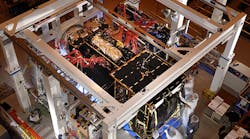The U.S. Air Force’s Space Based Infrared System (SBIRS) includes a mix of Geosynchronous-Earth-Orbit (GEO) satellites, hosted payloads in Highly Elliptical Orbit (HEO), and ground hardware and software. The system helps provide information for continuous early warnings of ballistic missile launches and other tactical intelligence. (See “SBIRS GEO Satellites Track Missiles Using Infrared Data”.) Recently, Lockheed Martin completed development of a next-generation ground system, Increment 2, to help increase SBIRS’ ability to manage emerging threats.
The legacy ground system currently in place operates from three different locations to manage the Defense Support Program (DSP), SBIRS GEO satellites, and HEO payloads. Increment 2 will consolidate those three separate operations into one control station. During a three-day test, the Air Force’s 460th Operations Group successfully used Increment 2 to individually transmit and receive commands to and from each of the DSP and SBIRS assets in orbit from the Mission Control Station (MCS).
Increment 2 will now move on to certification testing, with an end goal of replacing the older system and improving performance by 2016. The system will continue to perform several main functions: mission planning/payload tasking, constellation management, mission processing, event reporting and data distribution, and ground control. The centralized operations will help enable warfighters to efficiently monitor worldwide threats and alert responders for more immediate action.
